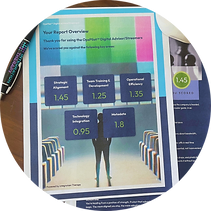Your Team's Moral Framework is Slowing You Down
- Rebecca Avery
- Jun 10
- 5 min read
Summary: This article explores how leaders can apply the well-established framework of moral development: pre-conventional, conventional, and post-conventional thinking, to better understand team dynamics and make smarter, more humane management decisions. Rather than using values as a hiring filter alone, this approach encourages leaders to align roles with how individuals make decisions under pressure. Drawing from personal experience, industry examples like Netflix, and organizational psychology, the piece argues that moral alignment is key to reducing burnout, unlocking talent, and building resilient teams. It’s not about judging people; it’s about designing roles and cultures that help people and companies thrive.

Every person on your team brings a different internal compass to work. Some seek structure. Others value group norms. A few are driven by deep principles, even if it means challenging the system.
If you don’t understand how someone navigates decisions, you might misread caution as resistance, loyalty as rigidity, or integrity as defiance. That’s not just a leadership blind spot; it’s revenue left on the table.
We’re taught to manage skills and performance. But rarely do we learn to recognize the moral logic underneath someone’s behavior. This is especially important in fast-moving, high-stakes environments like streaming, where ethical calls and cross-functional friction are common.
Kohlberg’s framework of moral development offers powerful and practical insights for organizational leaders. By understanding how individuals make decisions- whether they are motivated by rules, group norms, or core principles - leaders can more effectively align people with roles that suit their natural decision-making styles.
This alignment goes beyond traditional skills-based management: it helps unlock trust, performance, and retention by ensuring that employees are set up to thrive rather than struggle against misfit expectations.
When leaders ignore these internal drivers, misalignment and burnout follow. Understanding moral frameworks helps you lead with clarity, reduce conflict, and design roles that reflect how people actually think.
This isn’t about judgment. It’s about alignment. And when roles align with how someone makes decisions, you unlock trust, performance, and retention.
Decades of research in organizational psychology show that values congruence, when people’s internal motivations match their roles and company culture, reduces burnout and boosts engagement. Kohlberg’s framework gives leaders a practical tool to spot and support this alignment, making it easier to get the most out of your people without burning them out.
Surprise! Netflix Is Already Doing This
Most companies either ignore moral frameworks or use them as a filter for "fit" against corporate values and existing culture. What they miss is matching people to roles based on how they think.
Netflix takes a different approach. Their HR model prioritizes autonomy, psychological safety, and values-driven structures. They create paths for people who thrive in structure and for those who challenge it. They reward judgment, not just compliance.
The result? Empowered teams, better decision-making, and high performance under pressure. They’re not just hiring for whatever skillsets thy can glean from the interview process - they’re designing their teams for how people think.
A Personal Note: When I Was Misaligned
At one point in my career, I got a VP job at at Allen Media. What I thought would be a role full of autonomy turned out to be a role that required conventional thinking: structure, loyalty, predictability. But I operate post-conventionally. I scan for blind spots, long-term risks, and system improvements. The chaos around me made it impossible to adapt.
I was expected to follow along while watching things unfold that I did not believe were right for the company or its employees. The dissonance became unsustainable and I was feeling unbelievable stress all the time. Eventually, I resigned, but during my exit I didn’t even have the language to explain why I was leaving, which only antagonized upper management.
That experience led me to pursue a master’s in organizational leadership. I needed to understand how these misalignments happen and how to fix them.
Here's my takeaway: misalignment isn’t a flaw. It’s a signal. Great managers recognize that and move people into alignment. When that alignment isn't possible, the most humane thing is to part ways. It's a tough series of events that companies and employees alike should be made more aware of, so we can all avoid undue unhappiness.
So, I made a cheat sheet for streaming companies. Here is Kohlberg's model, adapted for streaming networks:
Stage One: The Pre-Conventional Orientation
Moral Framework: Avoid punishment. Get rewarded.
Core Thought Loop: "What do I need to do to stay out of trouble or get what I want?"
What you might observe:
Reluctance to act unless a consequence or incentive is clear
Reliance on checklists, direct instruction, or fixed routines
Discomfort in ambiguous situations or open-ended tasks
Avoidance of responsibility when outcomes are uncertain
Where they thrive: Rigid workflows, repetitive tasks, clear rules. Think metadata tagging, QC, ingestion, or finance ops. They can evolve to be master specialists if they understand the parameters.
Signs of mismatch: Placed in a role requiring abstract judgment or strategic initiative, they may stall or escalate unnecessarily. They’re not underperforming. They’re out of alignment.
Support they benefit from: Structure. Clarity. Frequent feedback. Explicit incentives.
Stage Two: The Conventional Orientation
Moral Framework: Follow the rules. Be a good teammate. Keep the system working.
Core Thought Loop: "What’s expected of me and how do I earn approval?"
What you might observe:
A deep commitment to norms, culture, and consistency
Sensitivity to team dynamics and group cohesion
Tension when asked to defy policies or upset norms
Focused on predictability, accountability, and being a solid contributor
Where they thrive: Vendor management, production planning, team leadership roles in known terrain. Operations, HR, Executive Assistants, and program management.
Signs of mismatch: Asked to lead a transformation or challenge outdated norms, they may hesitate or cling to consensus. It’s not fear you're witnessing, it’s fidelity to order and a lower risk tolerance than the task may call for.
Support they benefit from: Clear norms. Recognition. Guidance on how and when it’s appropriate to push against structure.
Stage Three: The Post-Conventional Orientation
Moral Framework: Integrity over approval. Systems thinking over status quo.
Core Thought Loop: "What’s the most ethical, sustainable path for the team and the company, even if it’s unpopular?"
What you might observe:
Willingness to challenge assumptions
Focus on purpose, ethics, and long-term outcomes
Discomfort in environments that reward conformity over truth
Natural inclination to protect people, principles, or systems from harm
Where they thrive: Strategy. Innovation. Transformation. Ethical risk-taking. Think content strategy, corporate development, strategic finance, or leadership during org redesign.
Signs of mismatch: If constrained by performative culture or punished for honest dissent, they disengage or leave. You haven’t lost a troublemaker, you’ve lost a truth-teller.
Support they benefit from: Autonomy. Psychological safety. Opportunities to align purpose with work. Transparency.
So What Do You Do With This?
1. Spot mismatches early. If someone’s stalling or shutting down, ask yourself: are they in a role that reflects how they process decisions? Are you asking someone who needs structure to lead a vision sprint? Or someone who questions systems to fall in line?
2. Promote consciously. Don’t promote based on output alone. Promote based on the kind of thinking the role requires. That’s how you avoid burnout, conflict, and misaligned expectations.
3. Design for developmental diversity. You need all three orientations on your team. But you need to know who’s who and lead accordingly. That’s not judgment. That’s design.
4. Watch for growth moments. Moral development isn’t static. People evolve, especially when challenged in the right way. Don’t assume a title shift means a mindset shift. Pay attention to how they handle ambiguity, tension, and power.
Final Thought: Moral Development Is an Org Design Lens
What if we hired not just for skills, but for moral range?
What if we didn’t just talk about values, but built teams around them?
What if we created orgs that could support rule-followers and system-challengers at the same time?
That’s not just good ethics. That’s future-proofing your company.




.png)